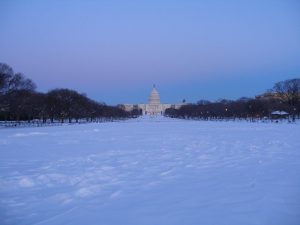
Looking east on the National Mall towards the Capitol in Washington, D.C., following the blizzard of February 9-10, 2011.
Credit: Carrie Smith/NOAA.
Winter storms and severe winter weather can bring dangerously low temperatures, strong winds, ice, sleet and freezing rain. These events can knock out a region’s heat, power, transportation and communication infrastructure, sometimes for days at a time.
Several American Geophysical Union scientists are available to comment on the science behind winter storms and severe winter weather, including storm forecasting, potential impacts and new weather observing technologies.
Laura Albert is a professor of industrial and systems engineering at the University of Wisconsin-Madison. Her expertise is in emergency medical response to 911 calls and in managing emergencies during severe weather events. She studies emergency response protocols during extreme weather conditions, such as blizzards and winter storms, and how these situations differ from emergencies during “normal” weather conditions.
Email: [email protected]
Phone: +1 (608) 262-0574
Jeffrey Deems is a research scientist at the CIRES National Snow and Ice Data Center and the NOAA Western Water Assessment at the University of Colorado Boulder. He studies seasonal mountain snowpack accumulation and melt processes using a combination of field measurements, remote sensing and model simulations. His work directly informs management of avalanche hazards for ski areas and transportation corridors and of water resources in snowmelt-dominated regions.
Email: [email protected]
Phone: +1 (303) 492.4743
Jordan Gerth is an Honorary Fellow with NOAA’s Cooperative Institute for Meteorological Satellite Studies at the University of Wisconsin’s Space Science and Engineering Center in Madison. His expertise is in applications for weather satellite imagery. He is actively involved with training National Weather Service meteorologists on the next-generation of geostationary and polar-orbiting satellites and helping install and maintain satellite-tracking antennas in and around the Pacific Ocean that collect data to improve computer forecasts of severe weather.
Email: [email protected]
Phone: Prefers email contact.
Sarah Kapnick is a Research Physical Scientist in the Climate Variations and Predictability Group at NOAA’s Geophysical Fluid Dynamics Laboratory. Her expertise is understanding snowfall and snowpack variability, predictability, and climate change globally, with sub focuses on the U.S., the South American Andes mountains and Himalaya region in Asia.
Email: [email protected]
Phone: +1 (609) 452-6548
Michael Notaro is an associate scientist and associate director of the Center for Climatic Research at the University of Wisconsin Madison. He is an expert on the variability, drivers, and future changes in lake-effect snow in Great Lakes Basin; changing lake temperatures and ice cover; and future changes in North American snowfall and snowstorm intensity and winter severity.
Email: [email protected]
Phone: +1 (608) 261-1503
Thomas Painter is a Principal Scientist at NASA’s Jet Propulsion Laboratory/California Institute of Technology and a Research Professor at the University of California, Los Angeles. His areas of interest are remote sensing of snow properties, snow hydrology, water resources from mountain snow and ice, and radiative impacts of light-absorbing impurities on snow and glacier melt.
Email: [email protected]
Phone: +1 (818) 393-8226
Charles Zender is a Professor of Earth system science and computer science at the University of California Irvine. He is an expert in the structure and reflectance of snow, including its density, shape, reflectance and susceptibility to warming/melt due to climate change.
Email: [email protected]
Phone: +1 (949) 891-2429
Looking for experts in other topic areas? Visit the AGU’s Stay Informed page for up-to-date expert lists.